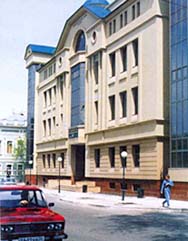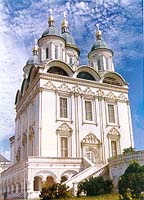Astrakhan
 The Astrakhan is known for contrasts - boundless steppes and shrub-grown banks, the north Caspian, ice-bound for half a year, and lush lotuses in the Volga estuary. With it inimitable beauty, eventful past and age-old hospitality, this land attracts tourists by the thousand. Its centre, the old city Astrakhan, sprawls along the Volga banks. The first written references to it go back to the 13th century, when the Astrakhan Khanate emerged in the lower reaches of the great river after the Golden Horde disintegrated. For several centuries, Astrakhan prospered on the crossing of trade routes which linked Europe and Asia. Today, Astrakhan is a major industrial and cultural centre of the Volga country, with a population of 1000,000. Every visitor is sure to be greeted here as a welcome guest.
The Astrakhan is known for contrasts - boundless steppes and shrub-grown banks, the north Caspian, ice-bound for half a year, and lush lotuses in the Volga estuary. With it inimitable beauty, eventful past and age-old hospitality, this land attracts tourists by the thousand. Its centre, the old city Astrakhan, sprawls along the Volga banks. The first written references to it go back to the 13th century, when the Astrakhan Khanate emerged in the lower reaches of the great river after the Golden Horde disintegrated. For several centuries, Astrakhan prospered on the crossing of trade routes which linked Europe and Asia. Today, Astrakhan is a major industrial and cultural centre of the Volga country, with a population of 1000,000. Every visitor is sure to be greeted here as a welcome guest.
Astrakhan began to acquire its present-day look after the year 1558, when the khanate was conquered and incorporated into Russia. A wooden fort rose on the high Hare Hill in the Volga estuary. In 1582, Tsar Ivan the Terrible sent Muscovite architects Dei Gubasty and Mikhail Velyaminov to add to it formidable walls of white limestone with eight towers. The citadel, locally known as Kremlin, received a magnificent Trinity Cathedral in the 16th century. The gorgeous Dormition Cathedral appeared early in the 17th. Built by serf architect Dorofei Myakishev, the edifice is unforgettable with its five cupolas, carved masonry, lacy cast-iron lattices, precious churchplate and exquisite icons. Later, St. Cyril`s Chapel and the bishop`s mansion with a church attached to it were added to the ensemble. Astrakhan developed apace with its new status of Russia`s south outpost, crossed by the Great Silk Route. It attracted merchants from Khiva, Bukhara, Persia and India, who put up in a caravan serai in the White Town, near the Kremlin. The Bukhara, Ghilyan and Indian arcades, and the Armenian and Persian trade missions came down to our day.
 The Astrakhan Museum of History and Architecture, with over 250,000 exhibits, has expositions in the Kremlin towers. They richly illustrate the history of a vast area in the Volga`s lower reaches from the Mesolithic Age to the present day, and demonstrate links between eras and nations, their customs, cultures, traditions and religions. The archeological collection, one of the museum's best, possesses Bronze Age weapons and jewellery, Scythian gold, treasures of the Sarmatian burial mounds, Golden Horde and mediaeval Russian coins, and Lamaist sacred articles. Of no lesser interest is the ethnological collection, with tools, household appliances, folk costumes and ritual vessels of ethnic entities who lived along the Volga in the hoary past ad later - Ases, Scythians, Sarmatians, Khazars, Nogais, Tatars and Kazakhs. The Astrakhan Museum of History and Architecture, with over 250,000 exhibits, has expositions in the Kremlin towers. They richly illustrate the history of a vast area in the Volga`s lower reaches from the Mesolithic Age to the present day, and demonstrate links between eras and nations, their customs, cultures, traditions and religions. The archeological collection, one of the museum's best, possesses Bronze Age weapons and jewellery, Scythian gold, treasures of the Sarmatian burial mounds, Golden Horde and mediaeval Russian coins, and Lamaist sacred articles. Of no lesser interest is the ethnological collection, with tools, household appliances, folk costumes and ritual vessels of ethnic entities who lived along the Volga in the hoary past ad later - Ases, Scythians, Sarmatians, Khazars, Nogais, Tatars and Kazakhs.
The late 19th century filled the Old Town, city centre, with gorgeous Art Nouveau houses - banks, posh shops, and offices of rich merchants and fishmongers. Most of these buildings came to us unchanged. Of special note amongthem are St. Vladimir's Cathedral, the Transfiguration Monastery tower, the former Azov-and-Don Bank, and the Astrakhan Cossack headquarters. A beautiful edifice in Sovietskaya St, one of the most interesting 19th century architectural monuments, now houses the municipal council. Russian wooden architecture is honourably exemplified by the Tetyushininov Mansion, ornate with lacy carvings of its window.
City's Day and Fisher's Day are the best-loved holidays in Astrakhan. The whole city is outdoors on City`s Day. The streets are decorated. Bands play in the squares and public gardens from morn to night. There are fetes and comic folk shows. The city market is at its noisiest and most colourful on this merry day. Astrakhan is Russia`s main fishing centre, so no holiday is more important here than Fisher`s Day, memorable with athletic events, concerts and art shows. The celebrations reach their peak when a motorboat appears on the Volga, carrying Neptune, heathen sea god and fishermen's patron, trident in hand, with a fancy-dressed retinue. At sunset, fireworks crown the glorious day.
The Astrakhan region has been the main seat of Russia`s fish-procession for over 400 years. It was royal fish supplier even in Ivan the Terrible's times. The Tsar`s banquets were gorgeous with Astrakhan sturgeon, caviar and sterlet soup. Fish and salt marshes brought abundant riches to local merchants, shipowners and fishmongers. The Volga creeks were busy day and night: fish were caught and dressed, and caviar salted in fenced - off sites. Today`s Astrakhan is the Caspian fishing capital, with mammoth spring and autumn catches of sturgeon and Volga herring. Farms have been established in the estuary toreplenish the fish population with small fry. Astrakhan is famous for fish procession, with delicious dried and smoked roach, smoked roach, smoked sturgeon, salt herring, exquisite canned fish and, last but not least, celebrated Russian caviar.
CITIES OF RUSSIA
Abakan I
Aginskoye I
Anadyr I
Arkhangelsk I
Astrakhan I
Barnaul I
Belgorod I
Birobidzhan I
Blagoveshensk I
Bryansk I
Cheboksary I
Chelyabinsk I
Cherkessk I
Chita I
Ekaterinburg I
Elista I
Gorno-Altaisk I
Groznyi I
Ioshkar-Ola I
Irkutsk I
Ivanovo I
Izhevsk I
Kaliningrad I
Kaluga I
Kazan I
Kemerovo I
Khabarovsk I
Khanty-Mansiysk I
Kirov I
Kostroma I
Krasnodar I
Krasnoyarsk I
Kudymkar I
Kurgan I
Kursk I
Kyzyl I
Lipetsk I
Magadan I
Maikop I
Makhachkala I
Moscow I
Murmansk I
Nalchik I
Naryan-Mar I
Nizhny Novgorod I
Norilsk I
Novgorod the Great I
Novosibirsk I
Omsk I
Orenburg I
Oryol I
Penza I
Perm I
Petropavlovsk-Kamchatsky I
Petrozavodsk I
Pskov I
Rostov the Great I
Ryazan I
Saint-Petersburg I
Salekhard I
Samara I
Saransk I
Saratov I
Smolensk I
Stavropol I
Syktyvkar I
Tambov I
Tomsk I
Tula I
Tver I
Tyumen I
Ufa I
Ulan-Ude I
Ulyanovsk I
Vladikavkaz I
Vladimir I
Vladivostok I
Volgograd I
Vologda I
Voronezh I
Yakutsk I
Yaroslavl I
Yuzhno-Sakhalinsk I
|